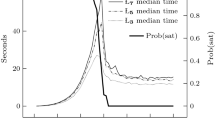Abstract
The problem of consistently assigning probabilities to logical formulas is an important problem. In this paper a set of logical formulas will be identified for which the problem can be solved. For every directed graph we define a set of logical formulas that it represents. If the underlying (undirected) graph is either perfect or t-perfect a closed form solution to the consistency problem can be given. A remarkable property of the class of formulas identified here is that it turns out to be closed under duality (if a set of formulas is represented by a digraph then the dual set of formulas is also represented by a digraph).
Similar content being viewed by others
References
K.A. Andersen and J.N. Hooker, “Bayesian logic,”Decision Support Systems 11 (1994) 191–210.
V. Chandru and J.N. Hooker,Optimization Methods for Logical Inference (Wiley, New York, to appear).
S.S. Chen, “Some extensions of probabilistic logic,” in: J.F. Lemmer and L.N. Kanal, eds.,Uncertainty in Artificial Intelligence 2 (North-Holland, Amsterdam, 1988).
V. Chvátal, “On certain polytopes associated with graphs,”Journal of Combinatorial Theory B 18 (1975) 138–154.
G. Georgakopoulus, D. Kavvadias and C.H. Papadimitriou, “Probabilistic satisfiability,”Journal of Complexity 4 (1988) 1–11.
M. Grötschel, L. Lovász and A. Schrijver,Geometric Algorithms and Combinatorial Optimization (Springer Verlag, Berlin, 1988).
T. Hailperin, “Probability logic,”Notre Dame Journal of Formal Logic 25 (1984) 198–212.
T. Hailperin,Boole's Logic and Probability, Second Edition, Studies in Logic and the Foundations of Mathematics v. 85 (North-Holland, Amsterdam, 1986).
P. Hansen, B. Jaumard and M.P. de Aragão, “Mixed-integer column generation algorithms and the probabilistic maximum satisfiability problem,”Proceedings of the Second IPCO Conference, Carnegie-Mellon University (1992).
B. Jaumard, P. Hansen and M.P. de Aragão, “Column generation methods for probabilistic logic,”ORSA Journal on Computing 3(2) (1991) 135–148.
R.G. Jeroslow, R.K. Martin, R.L. Rardin and J. Wang, “Gainfree Leontief substitution flow problems,”Mathematical Programming 57 (3) (1992) 375–414.
R.G. Jeroslow and J. Wang, “Integral polyhedra and Horn clause knowledge bases,”ORSA Journal on Computing 1 (1) (1989) 7–19.
D. Kavvadias and C.H. Papadimitriou, “A linear programming approach to reasoning about probabilities,”Annals of Mathematics and Artificial Intelligence 1 (1990) 189–206.
S.L. Lauritzen and D.J. Spiegelhalter, “Local computations with probabilities on graphical structures and their application to expert systems,”Journal of the Royal Statistical Society B 50 (1988) 157–224.
N.J. Nilsson, “Probabilistic logic,”Artificial Intelligence 28 (1986) 71–87.
J. Pearl,Probabilistic Reasoning in Intelligent Systems: Networks of Plausible Inference (Morgan Kaufmann, Los Altos, 1988).
R.D. Schachter, “Evaluating influence diagrams,”Operations Research 34 (1986) 881–882.
A. Schrijver,Theory of Linear and Integer Programming (Wiley, New York, 1986).
Author information
Authors and Affiliations
Rights and permissions
About this article
Cite this article
Andersen, K.A. Characterizing consistency in probabilistic logic for a class of Horn clauses. Mathematical Programming 66, 257–271 (1994). https://doi.org/10.1007/BF01581149
Received:
Revised:
Issue Date:
DOI: https://doi.org/10.1007/BF01581149




